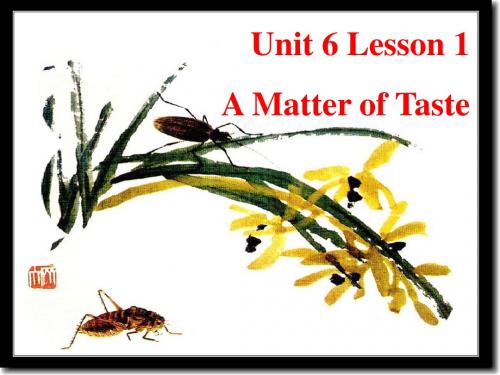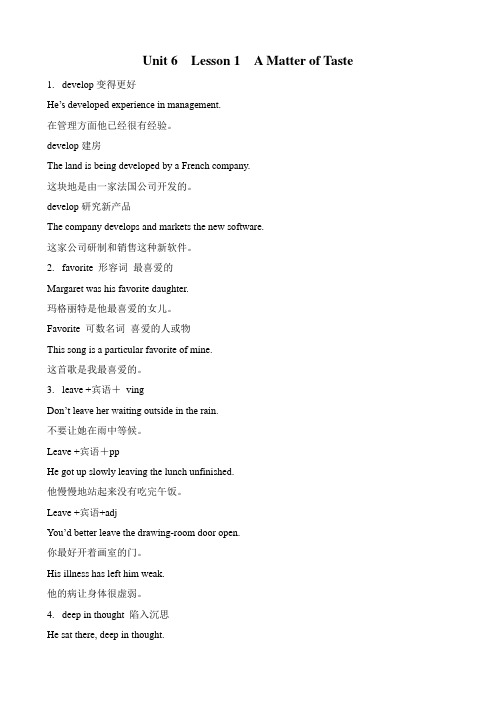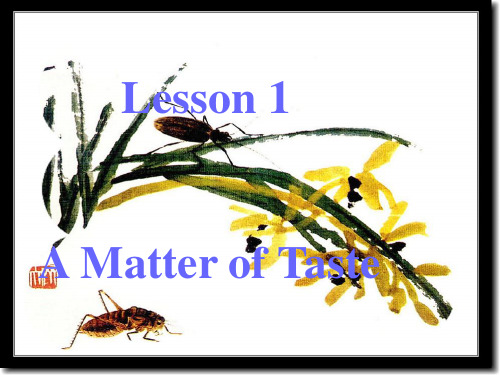北师大英语 Unit 6 Lesson 1 A Matter of Taste
- 格式:doc
- 大小:31.00 KB
- 文档页数:4



Unit 6 Lesson 1 A Matter of TasteTeaching aims: 1. To read a text and take notes on it.2. To help the students appreciate the paintings.3. To help the students describe the paintings.4. To practise using vocabulary of describing the paintings. Important points: 1. To help the students appreciate the paintings.2. To help the students describe the paintings.3. To practise using vocabulary of describing the paintings. Difficult points: 1. To help the students appreciate the paintings.2. To help the students describe the paintings.Teaching procedures:Step 1: RevisionGet the students to describe the paintings. Take a painting as an example.Eg: A. Guernica-PicassoThis is a realistic painting. The painter was Picasso. It was painted by Picasso. The subject of the painting was war. The painting was dark. The shapes are round, square and clear. The lines are wavy. In my opinion, I don’t like this painting. It is too pessimistic.Get the to choose one painting to describe.Step 2: Lead-inT: Just now we described some paintings drawn by foreign painters. Now let’s have a look at our Chinese paintings. Look at the three paintings at P36 and discuss in groups:Which do you like best? Why?What will you think of when you see the paintings?Eg:1)People should work harder. People can’t give up or stop, they must carryon.2)The insects like to eat vegetables. The green vegetables are good forhealth. Even a rearhorse it. We can show the painting to a child whodoesn’t like vegetables.3)In the old time there were some ladies in rich family, they had nothing todo everyday, spent most time thinking, feeling sad. They waste precioustime.Step 3: ReadingT: We have just talk about these three paintings. If you want to know more about the paintings and painters. Let’s read the text to get more information.Task 1: Read fast and complete the notes.Task 2: Find the words in the text with the definitions.Paragraph 1:1.something that people have done for a long time and continue to do: custom2.to help the progress of something3.having a lot of new ideas4.beautiful handwriting5. people who watch or listen to a performance6. ability to form new ideas and to make pictures in one’s mind7.living being, esp. an animal8. a way of doing something9. to say strongly that something is importantRead the text carefully and complete the notes.1.The life of the artists2.The description of the three paintingsDescribe the life of the artists and the pictures in your own words. Try to use the form to help you.Group 1 the life of the artistsGroup 2 Picture 1Group 3 Picture 2Group 4 Picture 3Step 5: Enjoy readingStep 6: Voice your opinion Culture comparing1. Which do you prefer, Chinese paintings or foreign paintings?2. Can you say some differences between Chinese paintings and foreign paintings in this lesson?Useful Language Points (If timepermits)Line 2: he developed the traditon of…develop: e.g.开发、发展、开展,1.His business developed quickly.发展2.We need to develop solar energy further.开发3.I developed the habit of eating between meals.养成了4.Please try to develop the idea more fully.说明Line 5: Across the paiting,named Racing Horse… we can …at high speed.在整幅被称作“赛马〞的画中,我们会看到一匹骏马在飞驰。


Unit 6 Lesson 1 A Matter of Taste 1.develop变得更好He’s developed experience in management.在管理方面他已经很有经验。
develop建房The land is being developed by a French company.这块地是由一家法国公司开发的。
develop研究新产品The company develops and markets the new software.这家公司研制和销售这种新软件。
2.favorite 形容词最喜爱的Margaret was his favorite daughter.玛格丽特是他最喜爱的女儿。
Favorite 可数名词喜爱的人或物This song is a particular favorite of mine.这首歌是我最喜爱的。
3.leave +宾语+vingDon’t leave her waiting outside in the rain.不要让她在雨中等候。
Leave +宾语+ppHe got up slowly leaving the lunch unfinished.他慢慢地站起来没有吃完午饭。
Leave +宾语+adjYou’d better leave the drawing-room door open.你最好开着画室的门。
His illness has left him weak.他的病让身体很虚弱。
4.deep in thought 陷入沉思He sat there, deep in thought.他坐在那儿,陷入沉思5.fix one’s eyes’ attention on 注视、注意She fixed her eyes on the clock.=Her eyes are fixed on the clock. 她眼睛一动不动地注视着表。

Unit 6 Lesson 1 A Matter of Taste教学设计3 Teaching aims:1. To know some famous painters in China as well as in foreign countries.2. To know several different kinds of painting arts3. To know some factors of paintings.4. To do some listening exercises5. To know deeply about painting culture.Important points:1. To know some famous painters in China as well as in foreign countries.2. To know several different kinds of painting arts3. To know some factors of paintings.Difficult points:1. To know several different kinds of painting arts2. To know some factors of paintings.Teaching procedures:Step 1: IntroductionGet the students to look at the top of the page. They will get to know theobjectives of this unit. Ask them:1) Which do you think is the easiest?2) Which do you think is the most difficult?3) Which are you most interested in?T: Some topics of this unit are very difficult to understand, but we can’t give up. Believe me, believe yourselves. Believe that we can pull through. Remember the saying? Difficulties are just like springs. You are weak, and they will be strong. So don’t be afraid of the difficulties. Ok? Step 2: Lead-in1. How many pictures can you see on this page?2. Are these pictures drawn by people or taken by cameras?T: Usually the pictures drawn by people are called paintings or drawings. Today let’s discuss somefamous paintings and some painters. There are many different kinds of paintings.Material: canvas, water color, brush drawing, painting in fresco.Style: realistic, abstract, pop, modern, classicalSubjects: portrait, self-portrait, landscape, drawing from natureStep 3: DescriptionLook at the paintings and describe them with the words given.Eg: A---- It’s very frightening painting. The lines and shapes are square and hard. They show violence and pain. We can see the horse and the mother with her dead child. It is Picasso, Spanish painter and sculptor’s painting.B----- It is called Improvisation 28- Wassily Kandinsky’s painting. It is an abstract painting. I t is hard to understand.C----- The painting is called A bigger Splash- David Hockney. It is a realistic painting of scenery with bright colors and clear shapes.D----- It is called Mona Lisa- Leonardo da Vinci, a Italian artist and painter.His paintings are characterized by vivid colors and analogies to music.Step 4: Do Ex 3 at P35.Listen and identify the paintings.Step 5: DiscussionIn pairs, students discuss the paintings, saying which they like most. Assist students, writing any words they want to know on the board.Step 6: Homework1. Word Corner at P79.2. Make preparations for Lesson One.。